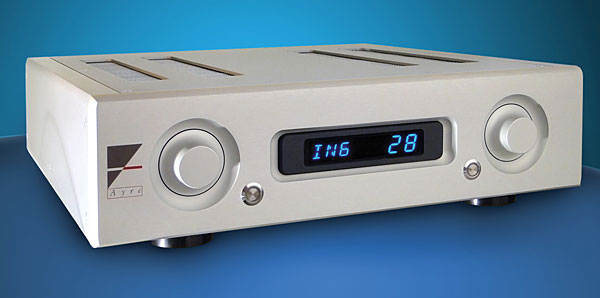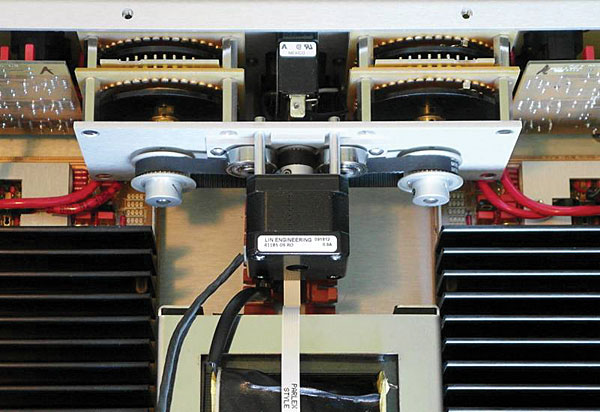[h=2]Ayre Acoustics AX-5 integrated amplifier Page 2[/h]
One could also rely on the included remote handset: a big, hefty, confidence-inspiring piece of metal that I came to enjoy more than most such devices. I especially enjoyed using its illumination button—the only soft-touch button on the handset that's set aside from all the others, allowing the user to more easily find it in the dark—which back-lights, for approximately eight seconds, all of the handset's soft-touch pictographs, most of which make sense. Two miscellaneous setup observations:
• With the AX-5, Ayre endures in using Cardas's proprietary single-knob speaker-terminal pairs, which favor spade lugs above all else. In past encounters with these terminals, which I admire for both their mechanical positivity and the quality of their construction, I managed to nonetheless fit my (preferred) banana plugs with a little effort. Yet on my review sample, the folks at Ayre had drilled, very precisely, a pair of holes on each Cardas terminal block, sized and placed perfectly for an average banana. I loved them. It still isn't clear whether this was done just for me, or if it's a modification that Ayre will apply to all units, but I hope it's the latter.
• The Ayre AX-5 ran hot. Not
the-curtains-are-on-fire hot, but hot enough. Compared to my Shindo combo of
Masseto preamplifier and Corton-Charlemagne monoblocks—representing exactly 20 vacuum tubes in all—the Ayre AX-5, by itself, made the room warmer.
Installation and Setup, Part Two
A day or two after my review sample of the AX-5 arrived, Ayre's Alex Brinkman visited my home to make sure that all was well. His helpful observations included: "This amp takes a long time to break in," "Remember to break it in," and "Remember to take a long time breaking it in." Brinkman is cool, so I said that I would.
When he got back to Ayre headquarters, in Boulder, Colorado, Brinkman sent me an e-mail: "Even though your unit was broken-in at the factory, with the AX-5, break-in is an even bigger deal than usual. So please . . ." You know where he was going with that. Yes, I made all the more sure to do a good job of breaking it in.
Brinkman's concern was fueled by his observation that, on at least one AX-5 in the field, pairs of inputs that had been used the
most sounded considerably better than those that had been used the
least; break-in time was assumed to be the cause of the disparity. To the dismay of all, that later proved untrue: It turned out that certain diodes used on the AX-5's input boards—used in protection circuits for the above-mentioned FET switches—were defective, and exhibiting leakage current. It was just a coincidence that a well-worn input sounded drastically better than an untouched one: The untouched one proved to be hobbled with leaky diodes.
Ayre got in touch with me—and with dealers who'd already sold AX-5s—regarding the problem and the fix, the latter requiring the field replacement of the old left- and right-channel input boards with ones that have newer, better, and altogether less leaky diodes. As per
Stereophile's policy, John Atkinson and I agreed to apply the fix to the review sample, albeit not before noting the pre-fix sound of that unit.
That sound was decidedly ordinary. During its first weeks in my home, before the board-swap, the AX-5 sounded good, but not $10,000 worth of good. Not by a long shot.
That was about to change.
Listening
What a good tube amplifier sounds like and what it plays music like are two different things. A good tube amp usually
sounds warm and colorful and well textured, often with a bottom end that's a bit fat and a treble range that isn't terribly trebly. A good tube amp
plays music in such a way that lines of notes have a sense of flow and momentum, with a distinctly forceful tactile quality: an unmistakably human sense of touch, from the subtlest sound to the bangiest.
When most audio salespeople describe a given solid-state amplifier as being
just the thing for tube lovers, here's what they usually mean: It sounds warm and has a fat bottom end and not a whole lot of highs. That's all well and good, but that isn't what I necessarily want to hear: What I want to hear is flow and momentum and a human sense of touch.
I have never heard a solid-state amplifier that could both
sound like and
play< music like the best tube amplifiers of my experience, but the warmed-up, broken-in, post-diode-fix Ayre AX-5 got a huge portion of the second part right. Through it, I found it easy to enjoy the records in my collection more as music than as sound, and while that may seem like faint praise, it is anything but.
Through the Ayre, "Renée Falconetti of Orléans," from Jenny Hval's
Innocence Is Kinky (CD, Rune Grammofon RCD 2142), sounded rather different than through my own combination of Shindo Masseto preamp and Shindo Corton-Charlemagne amplifiers: the latter imbued the music with much fuller, more colorful bass; the former was much more explicit about not only the lyrics being sung but also details in the arrangement. (Stacking of voices, especially, was far easier to hear and appreciate through the Ayre.) But the Ayre allowed the music
almost as much force, from the stringy-sounding keyboard bass that opens the song through the compellingly sung litany at the end. And the Ayre gave it the same relentlessness, the same hypnotic
flow. The two different experiences were differently enjoyable and insightful.
During the AX-5's time in my home, the experience of listening to David Grier's
I've Got the House to Myself (AIFF file ripped from CD, Dreadnought 0201) was equal parts pleasant, exciting, and very insightful, the last quality more than I'm used to. Apart from three original tunes, this is a collection of mostly flatpicking standards—a sort of bluegrass version of Joe Pass's
Virtuoso album—in which the guitarist begins each number by hewing to the melody, followed by a series of variations. Through the Ayre, the balance of incisive detail, perfect musical timing and momentum, and naturally warm timbral colors allowed me to follow and understand each variation with fresh ears. And when, in the alternate-tuning number "Evening Prayer Blues," Grier moves from softly picked lines to a series of forceful bendings of the bottom string, the effect was magnificent—and remarkably lifelike.
In what may, to some enthusiasts, be its most compelling strength, the AX-5's clarity of detail and clarity of
line seemed allied to the amp's clarity of space: The sense of openness with which the Ayre presented spatial elements contained in good stereo recordings—details of size, of wholeness, of position and perspective—was exceptional. With recordings that strive for a natural presentation, such as André Previn and the London Symphony Orchestra's recording of Tchaikovsky's
Manfred Symphony (LP, EMI/Alto ASD 3018), the Ayre communicated a natural perspective with believable hall sound and an exceptionally good (I'm tempted to say "tube-caliber") sense of scale. On the other hand, with those stereo recordings whose imaginary stages are more an artificial creation, as on Joanna Newsom's Ys (AIFF ripped from CD, Drag City DC303CD), the Ayre held my attention with its ability to make unlikely sonic juxtapositions sound convincing.
Of course, that least appealing of all transistor-amp qualities—that they reliably allow horrid recordings to sound as horrid as they are—was also present and accounted for:
eg, the screechy and grainy Barber
Adagio for Strings, by Leonard Bernstein and the New York Philharmonic (CD, Columbia S3K 90578). The awfulness of Columbia's classical sound has been greatly exaggerated with regard to some of their recordings, but not this one. Similarly, though the Ayre was itself never bright per se, the sound of Peter Rowan's eponymous debut album (LP, Flying Fish 071) certainly was, as heard through the AX-5.
Although never sounding quite tube-like in the most obvious ways, the AX-5 provided good if not generous amounts of timbral color, and very good levels of natural instrumental texture: The sounds of antique wind instruments in particular, as throughout Musica Antiqua Vienna's
Le Jardin Musical (LP, Supraphon 1 11 2126), were pleasantly tactile. Overall balance was quite good: decidedly modern, but not the least bit bright. Electric basses sounded appropriately full and no more—as with Colin Moulding's excellent lines throughout "Books Are Burning," from XTC's
Nonsuch (CD, Geffen GEFD-24474). And the sound of a low D-flat from a digital bass keyboard in "Amen," from Leonard Cohen's
Old Ideas (AIFF ripped from CD, Columbia 88697986712), showed that the Ayre's bass performance could be perfectly scary when called for. Nice.
Conclusions
At the start, I was dubious (as one should always be, I suppose): With its lack of a phono preamp, its lack of traditional controls, and its lack of tubes, the Ayre AX-5 is a few steps to the right of my comfort zone. By the end of its time here, I was extremely impressed—especially with the warmth, color, and clarity I heard while this amp was busy driving the hell out of
DeVore Fidelity's Orangutan O/96 speakers.
On the minus side, the AX-5 is more difficult to configure than it needs to be, not as luxuriously finished as it ought to be, and not
quite as flexible as I would want it to be. I would gladly trade the ability to set input-specific levels, and even the ability to dim or extinguish its lighted panel, for a balance control or a mono switch.
On the plus side, it's one of the three best, most musical, most human-sounding solid-state amps I've ever heard, in which regards it rivals the
DNM PA3-S and the
darTZeel NHB-108. Heck, it's one of the finest amps I've lived with, period. As such—
and as something that takes the place of both preamp and power amp, and to which one need add only a good phono preamp—the AX-5 is a respectably good value. I can imagine this product becoming something of a standard, and deservedly so.


